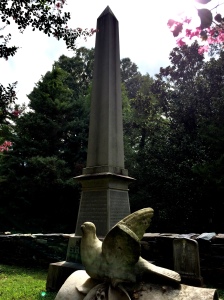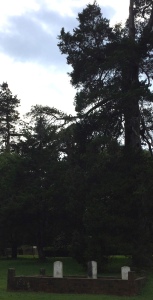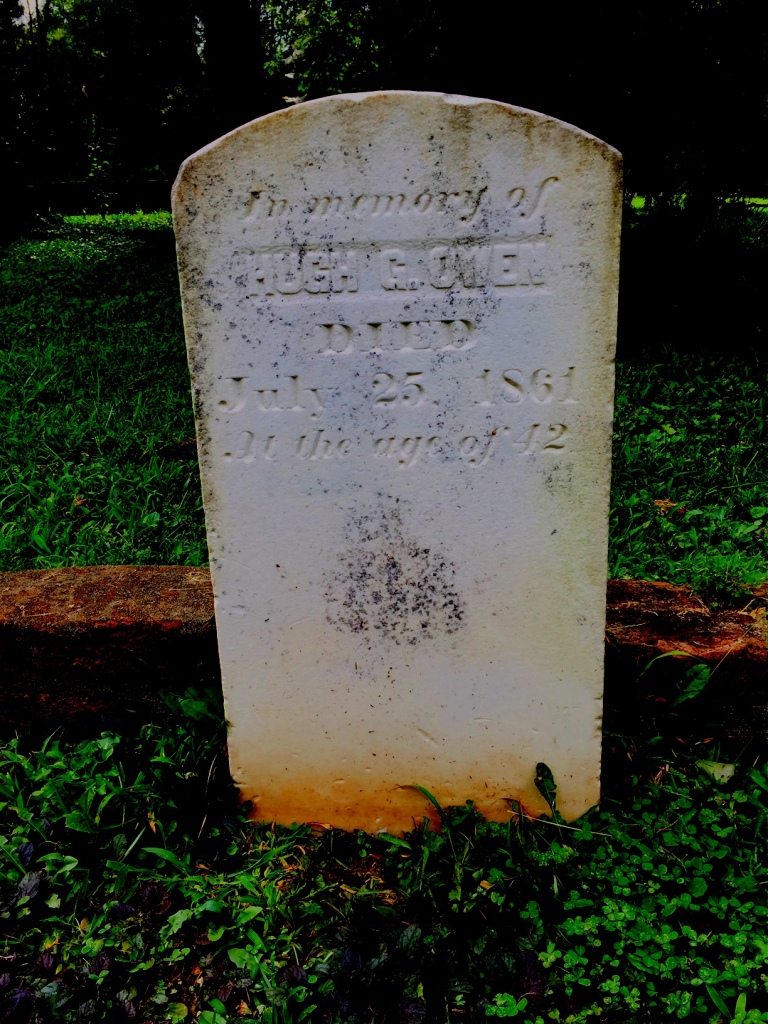Isle of Jura Mellow Corn
Rare Seared Tuna Tacos w/Asian Slaw, Farm Cucumber, Sriracha
There are five notable cemeteries in my town of Hillsborough, North Carolina. Six if you count the one underneath my house. If you read last week’s entry, (31, scroll down) you know that my advisor, Dr. Aiden Mann, who lives at a long gray table on the second floor of the local library, suggested that I might be able to solve my present “problem” by researching local graveyards. My problem? There is an entity living (living?) in the crawlspace beneath my house.
She appears to me to be a young girl. I’m told, by the mysterious and missing Rafe — an expert on things that should be dead but somehow aren’t — that she is the — pardon the term — “ghost” of a slave girl who died approximately 170 years ago and who was buried, or misburied, if there is such a thing, beneath my house or maybe she was buried there and my house was dragged over her grave. It’s unclear. Just one of the many mysteries that cling to my old, M.C. Escher-like house.
(Aside) By now readers of this blog know that my house started as two rooms moved from the nearby historical Ashburn school to where my house is now. These two wooden rooms have been built onto in a mostly reasonable fashion over the last 160 or so years. When I wrote the words above, “M. C. Escher house,” I almost added “Like Topsy, over the years it just growed.” But I stopped myself, wondering if what to me was a familiar and benign phrase (hardly ever heard these days) had become, in some way, offensive. So I didn’t put the sentence in, and now that bothers me, so I’d like to discuss it. (And I’d like to hear comments about the phrase from any readers familiar with it.)
When I was a kid, adults might discuss something that had occurred without anyone noticing, that had come into existence and become remarkable in some way. At this point someone might ask how the particular thing had come to be without anyone noticing and someone else (always an adult) might say, “Well, I guess it’s like Topsy, it just growed.” And everyone would nod in agreement. I remember hearing my mother say that phrase to me one day when we were discussing some subject I have long forgotten. I didn’t understand what she was talking about and was surprised to hear my mother use language that even I, at whatever young age I was, knew was not “correct” grammar. Yes, we were West Virginians but woe betide if you ever used the word “ain’t” or any other hillbilly words in our household. (I now find myself wondering if anyone uses the phrase “woe betide” any more. This was also commonly used when I was a kid. As in, ‘Woe betide if you touch any of these cookies I just baked!’ Usually spoken in a mock dramatic voice. Meaning some terrible punishment would fall upon your head.) So I asked what she meant by “growed.” Mom told me that the phrase came from a book which she read and loved as a child called Uncle Tom’s Cabin, which was about a young slave girl named Topsy who had very little education and referred to herself when asked where she came from as having “just growed.” Over the years I heard this expression quite a few times, and then I never heard it again in ordinary usage except spoken ironically. (Almost always by me.) So I just looked it up and found the following:
“St. Clare’s daughter Eva becomes friends with the young slave girl Topsy, and the novel recounts a conversation between Topsy and St. Clare’s cousin Ophelia: “Have you ever heard anything about God, Topsy?” The child looked bewildered, but grinned as usual. “Do you know who made you?” “Nobody, as I knows on,” said the child, with a short laugh. The idea appeared to amuse her considerably; for her eyes twinkled, and she added, “I spect I grow’d. Don’t think nobody never made me.” [Chapter XX]
Given the astounding popularity of “Uncle Tom’s Cabin” (at the time of its publication it outsold every book previously published in the U.S. except the Bible), legions of readers were charmed by Topsy’s declaration that she just “growed.” Soon “it growed like Topsy” had become a popular figure of speech to describe something that grew or increased by itself, without apparent design or intention.
(Thus ends the Aside.)
Before my self-interruption, I was discussing the spirit that lives beneath my unusual house. Her name, Rafe says, is Ada. How does he know? I wish I could find him to ask this question, and others.
I have been living with this mostly benign, sometimes not, apparition for almost a year. If you start at the beginning (scroll way down!) you will understand the story and where we are now. I have learned, in my way, to accept it as, well, not normal, but just the way it is. I’ve been hoping for many months that somehow the situation would resolve itself: it hasn’t. That my friend Rafe will solve it for me: he hasn’t. That I can convince myself to just ignore it: I can’t.
Last week (see entry 31) I skulked downstairs in the middle of the night, rolled up the rug in my wife’s office, lay (laid?) down on the floor and put my ear to the old, ancient wooden boards and heard Ada, my Ada, weeping. It’s a sound you would have to hear yourself to understand why I have to stop it. It’s a mournful lament that can’t be borne, at least by me, without trying to do something about it.
So on the way to the Penny the other day, Sherry and I visited the old graveyard by the historic Presbyterian Church on the main street, Churton, in town. This was the first official graveyard in historic Hillsborough and many of the luminaries of those early days are interred here. You enter the graveyard through one of two gates, on either Churton or the cross-street, Tryon. (Formally Church Street in the olden days.) There is a small sign at either entrance explaining that over the years so many tourists have made rubbings of the headstones they have become worn down to such an extent that many have become unreadable. So, no gravestone rubbings, please.
Sherry wondered, as we went in through the Tryon Street entrance, why I was suddenly interested in graveyards. Since she doesn’t know about Ada and my midnight excursions, I mumbled some excuse. I guess she bought it; at any rate she didn’t ask for a further explanation.
The cemetery grounds run about an acre in total and might be described as a bit gloomy, but what self-respecting graveyard isn’t? The headstones are indeed well worn, as you would expect since the cemetery dates officially from 1754 and local lore says folks were being buried there even before that date. The names on the headstones are names well known to historic Hillsborough: Among them, William Alexander Graham, N.C. governor, vice presidential candidate and U.S. and Confederate States senator; John Knox Witherspoon, first pastor of the Presbyterian church which is where the graveyard is situated, a young man once considered the savior of the modern Presbyterian church; Frederick Nash, North Carolina Chief Justice; William Hooper, one of the Revolutionary War’s leading lights and a signer of the Constitution; William F. Strayhorn, Mayor of Hillsborough, and his wife Harriet, who was the town postmistress; and many other illustrious citizens. As you move through the more restricted, fancy-pants part of the cemetery you come to the public burial area where there are far fewer tombstones, and where ground-penetrating radar shows probably 100 unmarked graves beneath the bucolic surface. One wonders where the original grave markers have disappeared to; sources suggest that thrifty Hillsboroughians pilfered them to construct the pillars beneath many of the houses, houses just like mine.
In the first area in the graveyard off Tryon Street is a tall obelisk commemorating the death of John Berry,  who was a famed local builder (he built the Hillsborough Courthouse among other famous buildings) who I mentioned in an earlier entry. Berry was the man who undertook the renovation of the nearby Ashburn School in 1850 and is listed as the first owner of the two-room schoolhouse that is the ancient core of my house, beneath which Ada is buried. From my study of other records, it appears that Berry sold this schoolhouse, now on my lot, to Lemuel Lynch, noted North Carolinian silversmith, who had a jewelry store on Churton Street in the center of town.
who was a famed local builder (he built the Hillsborough Courthouse among other famous buildings) who I mentioned in an earlier entry. Berry was the man who undertook the renovation of the nearby Ashburn School in 1850 and is listed as the first owner of the two-room schoolhouse that is the ancient core of my house, beneath which Ada is buried. From my study of other records, it appears that Berry sold this schoolhouse, now on my lot, to Lemuel Lynch, noted North Carolinian silversmith, who had a jewelry store on Churton Street in the center of town.
Remember those names. Lemuel Lynch and John Berry. They will appear on these pages again.
The mosquitos were chewing Sherry up, so we moved on to the Penny. Continuing my 69 drinks quest, I had an excellent scotch, a ten year Isle of Jura. It was very good, one of their least pricey brands coming in at around $50.00 a bottle. The Internet tells me that Jura is an island in the Inner Hebrides off the West coast of Scotland and it has one road, one pub, one distillery, 200 people and 2000 red deer. It is very difficult to get to. Sounds like a perfect place to spend six months or so while writing my next novel.
We shared a plate of chicken wings, and I had a shot of Basil Heyden’s Bourbon. This is a medium/higher priced bourbon that I’ve had before. At $50.00 a bottle it’s a little pricey, but it’s good. Maybe I like it because it has a high rye-to-corn ratio. It pairs well with chicken wings, but what doesn’t?.
On the way back up the hill Sherry went on ahead (those damn mosquitos) while I leaned on the old stone fence on the east side of the Presbyterian graveyard. There were lots of fences around these old cemeteries to keep out the cows and the semi-feral pigs that wandered the streets in the olden days. There were actual laws about cemeteries, walls, and pigs, enacted more than several hundred years ago. If left to their own brutal natures, pigs tend to dig up buried bodies and try to eat them. Hence the walls.
On the eastern side of the tract where I was leaning on the stone wall is a set of three headstones.  Beneath the ground in this eastern section are at least 100 unmarked graves. It was evening now and the graveyard had a gloomier feel; it seemed like I could sense those buried, unmarked 100 souls who were lost to history. I wondered if one of those pilfered gravestones was now shoring up a pillar underneath my house.
Beneath the ground in this eastern section are at least 100 unmarked graves. It was evening now and the graveyard had a gloomier feel; it seemed like I could sense those buried, unmarked 100 souls who were lost to history. I wondered if one of those pilfered gravestones was now shoring up a pillar underneath my house.
It’s difficult to tell from the picture below, probably because the stone is worn away from all those tourists making rubbings, but the dead man is Hugh G. Owen, who died the morning of July 15, 1861. I went home and looked up the Hillsborough Record and after scrolling through several issues around the July 15thdate, I found a notice of Hugh’s death. The photocopy of the original newspaper was so bad I spent considerable time puzzling out the particulars, but I could see that the Record reports that the cause of death was “Intemperance.” I felt the pull, across time, of a kindred spirit. Perhaps Hugh was embarked back then on his own version of 69 drinks, or maybe it was 6900 drinks, when death claimed him at the age of 42 years. It was certainly uncharitable for the newspaper to announce the cause of his death as intemperance, which must have been an embarrassment to his mother who was still living at the time of his death. And people think newspapers are cruel and vindictive these days.
Rest in Peace, Hugh Owen, rest in peace.

My laptop spazzed out while commenting earlier. I just want to compliment you on the blog! I was not familiar with M.C. Escher by name, but with his work. I googled his name and realized I posted his Relativity lithograph on Facebook recently. What I like about your style of writing is the way you entwine History with your story. There are many beautiful facets to this, one being it inspires research on the part of the reader by sparking an interest in times gone by and places. Thank you
LikeLike
Thanks. I always look forward to your comments.
LikeLike
Random comments triggered by Thirty-Two.
*intemperance was not uncommon in the 19th century as folk dealt with life-pain. I wonder if small town papers today in West Virginia, Ohio, and other regions include cause of death by ‘opoids’ or ‘overdose’?
*maybe Ada, with her life (or death) pain would benefit from a little intemperance.
*the Topsy aside reminded me of an old Shel Silverstein poem I remember as:
Chester came to school and said,
Dern, I growed another head.
Teacher said,
It’s time you knowed
The word is grew instead of growed.
*just returned from a week visiting my scotch-drinking friend. In appreciation of his hospitality, room, and abundant board, I left him a bottle of 18 year-old Isle of Jura. He called last week the day after I got home to say it was the best tasting scotch he had ever had. The Isle of Jura calls for you and your pen.
LikeLike
Yes, most folks drank far more alcohol then than we do now, though that besides hard times was often because the water was always suspect. Even children in boarding schools were served “small beer” instead of water.
The Silverstein poem is great, I’ll bet the takeoff was from the Topsy comment.
Someday I’ll try that 18 yr. Jura, I’m sure it must be great.
The comment section isn’t letting me post a picture of the obit from the Hillsborough Record but the obit reads,
“Died in Hillsborough on the morning of the 15th of July, Mr. Hugh G. Owen. His death is another example how intemperance destroys fine natural gifts, capability and highly pleasing social virtues. A merciful God allows sorrowing friends such consolation as can be derived from the words “pray for me” which he uttered to his mother and his eldest sister shortly before he died.”
At first I thought they were quoting Jesus in the above obit but I now realize that the lower case h on the word he means it was Owen himself who was asking for prayers.
Other research shows that at some point Owen’s brother Henry was fined by the city for cutting down a tree that he wasn’t supposed to cut down. Who knew that they cared about trees so much back then.
LikeLike
P.S. I believe Ada is too young for intemperance though that may be because that’s how I “see” her rather than how old she was when she died. Besides, there is the matter of that bottle of whisky or whatever it is that was jammed into the pillar under there.
LikeLike
Thanks Allen, so enjoying your blogs……….I never heard of Topsy used in a sentence before and now I may become addicted to finding excuses to use ” just growed” but woe betide?… ohhhh yes. I can see my Grandmother’s index finger waving .
Maybe Sherry could try some Avon Skin So Soft to keep those mosquitoes at bay, it really works!
Now that you’ve referred to your house as an MC Escher house all I can see is stairs going up and stairs going down.
LikeLike
We have a guy Mosquito Joe who comes and sprays every three weeks or so. They swear it doesn’t hurt the bumblebees, which I would like to believe, but in two years I’ve had one mosquito bite and that was when we were of at the Pickle Festival. (Far more boring than it sounds.) Also it deals with the ticks which I am really worried about. And yes, there are stairs going up and down.
LikeLike